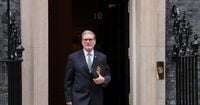On Friday, October 17, 2025, a dramatic courtroom scene unfolded at London’s Central Criminal Court, commonly known as the Old Bailey. Two Ukrainian nationals, Roman Lavrynovych, 21, and Petro Pochynok, 35, appeared via video link from HMP Belmarsh, pleading not guilty to charges of conspiracy to commit arson with intent to endanger life. The accusations stem from a series of fires in May 2025 targeting properties linked to the current UK Prime Minister, Keir Starmer, in north London. The case, which has gripped the British media and provoked concern about political safety, is not being treated as terrorism, but the motives behind the attacks remain shrouded in mystery.
Alongside Lavrynovych and Pochynok stands a third defendant: Stanislav Carpiuc, 27, a Romanian national born in Ukraine. Carpiuc, who dismissed his legal team earlier in the week, did not enter a plea during the hearing. All three men were assisted by interpreters, reflecting the international dimension of the case. The trio are accused of conspiring to damage property by fire “belonging to another and intending to endanger the life of another or being reckless as to the life of another would thereby be endangered,” as reported by BBC.
The charges relate to three separate incidents, all occurring within a five-day window in May 2025. The first fire erupted on May 8, when a Toyota RAV4—previously owned by Prime Minister Starmer—was found ablaze on a street in Kentish Town, north London, where Starmer had lived before ascending to the premiership. According to Reuters, the car had been sold to a neighbor, but the link to Starmer was unmistakable. Just three days later, on May 11, a fire broke out at the front door of a house converted into flats in Islington, another property associated with Starmer. Firefighters, equipped with breathing apparatus, rescued one person from the building, underscoring the potential danger of the attacks.
On May 12, the third and final incident occurred: the entrance to Starmer’s four-bedroom Kentish Town home, which was being rented out at the time, was charred after being set ablaze. This property, valued at approximately £2 million, had been Starmer’s family residence before he moved into 10 Downing Street following his election as Prime Minister in July 2024. Fortunately, no injuries were reported across any of the three incidents, though the psychological impact on those targeted—and the wider public—has been significant.
The prosecution, led by Sarah Przybylska, made it clear that the case is not being treated as terrorism or as having national security implications. “We are not presenting the case as being connected to terrorism or national security,” Przybylska stated, as cited by Reuters. This sentiment was echoed by Mrs Justice Bobbie Cheema-Grubb, who presided over the hearing. She described the circumstances of the alleged offences as “somewhat opaque,” adding, “Plainly they are coordinated and must have some motive or purpose behind them.” The judge’s remarks left the court—and the public—pondering what could have driven such a targeted series of attacks.
All three defendants were remanded in custody, with a further hearing scheduled for November 28, 2025. A provisional trial date has already been set for April 27, 2026, in front of a High Court judge. The legal process is expected to be lengthy and complex, given the international backgrounds of the accused and the high-profile nature of the alleged victims.
Throughout the proceedings, the defendants were separated in different rooms inside HMP Belmarsh, communicating with the court through interpreters. Carpiuc, who had already held more than 20 conferences with his previous legal team, submitted what the court described as an “inadequate” witness statement. His co-defendants, Lavrynovych and Pochynok, have not yet filed any witness statements of their own, according to Evening Standard.
The fires themselves were notable not only for their coordination but also for their symbolism. As the Associated Press reported, Starmer condemned the attacks as “an attack on all of us, on democracy and the values that we stand for.” His words reflect the broader anxiety felt in British politics about the safety of public figures and the resilience of democratic institutions. Since moving into the official Downing Street residence, Starmer and his family have not resided at the targeted properties, but the message sent by the attacks has not been lost on the political establishment.
Media coverage has focused on the details of the incidents and the backgrounds of the accused. Lavrynovych, an aspiring model from Sydenham, south-east London, and Pochynok, who resides in Islington, north London, were both described as calm during their appearance. Carpiuc, a roofer from Chadwell Heath, east London, appeared similarly composed, despite the gravity of the charges. The men’s presence in London and their alleged coordination has raised questions about how and why these particular properties were chosen, but so far, neither prosecutors nor the defense have offered a clear explanation.
Investigators have not found evidence to suggest a terrorist motive, nor have they linked the attacks to broader national security concerns. The Crown Prosecution Service has emphasized that the focus remains on the specific allegations of arson with intent to endanger life. Each of the fires was set deliberately, and the pattern suggests planning and intent, but the underlying rationale is, as Justice Cheema-Grubb put it, “somewhat opaque.”
In the aftermath of the incidents, the London Fire Brigade and Metropolitan Police responded quickly, containing the blazes and launching a thorough investigation. The rescue of a resident from the Islington flats on May 11 highlighted the risks posed to innocent bystanders, and the authorities have been keen to reassure the public that there is no ongoing threat. Nevertheless, the case has prompted renewed debate about the security of political leaders and the adequacy of protections for those who have recently left office or moved to new residences.
The accused men’s next court appearance is set for late November, when further case management will take place. The trial, scheduled for April 2026, is expected to shed more light on the origins and objectives of the alleged conspiracy. For now, the British public—and the political world—are left with more questions than answers, as the investigation into this unsettling series of attacks continues.
With the trial on the horizon and the facts still emerging, all eyes will remain on the Old Bailey as the justice system seeks to unravel the motives behind a case that has shaken the heart of British political life.


